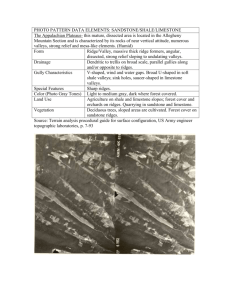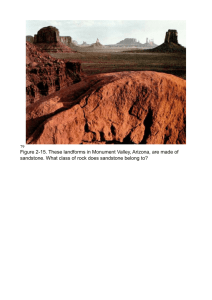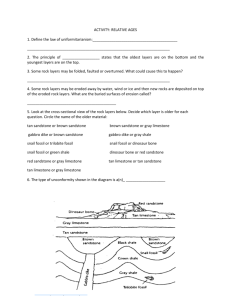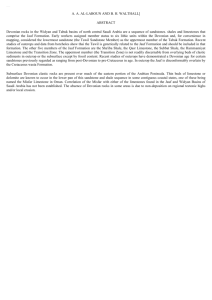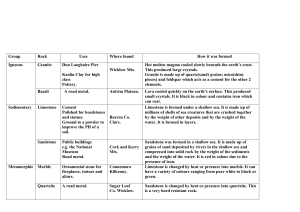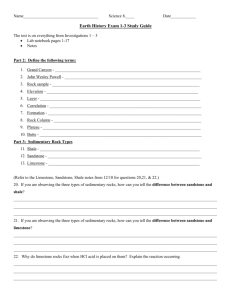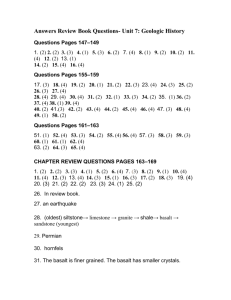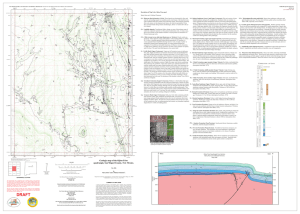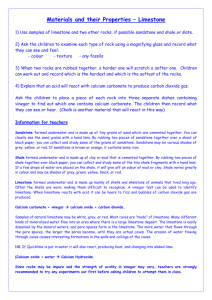Description of Map Units: Ojitos Frios quad
advertisement
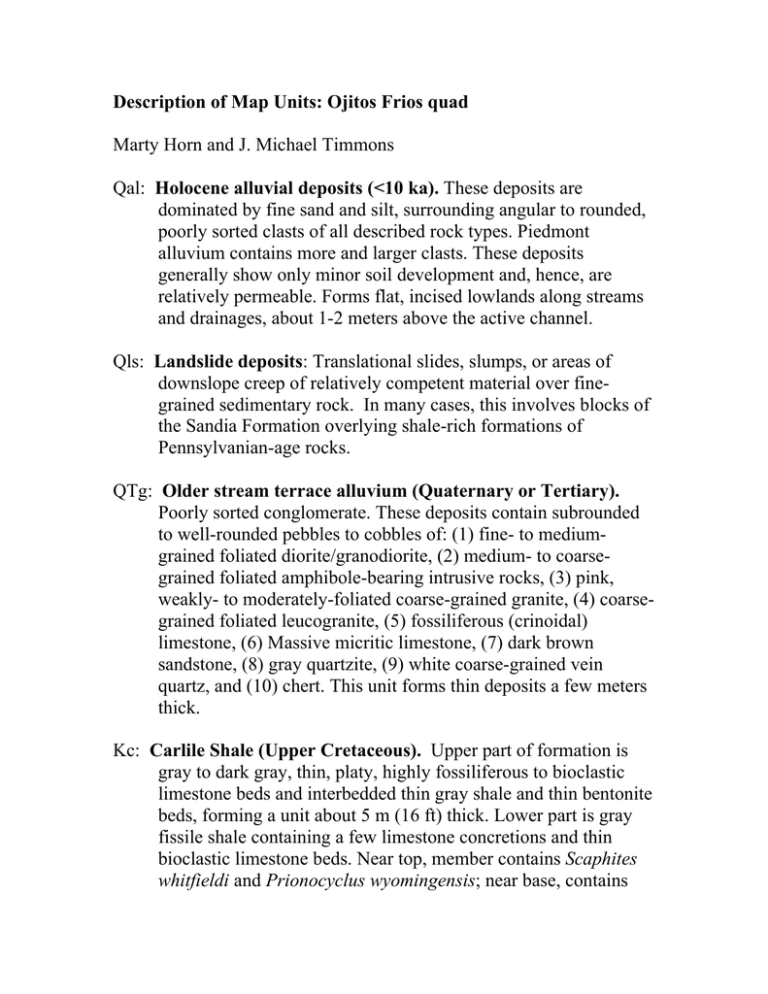
Description of Map Units: Ojitos Frios quad Marty Horn and J. Michael Timmons Qal: Holocene alluvial deposits (<10 ka). These deposits are dominated by fine sand and silt, surrounding angular to rounded, poorly sorted clasts of all described rock types. Piedmont alluvium contains more and larger clasts. These deposits generally show only minor soil development and, hence, are relatively permeable. Forms flat, incised lowlands along streams and drainages, about 1-2 meters above the active channel. Qls: Landslide deposits: Translational slides, slumps, or areas of downslope creep of relatively competent material over finegrained sedimentary rock. In many cases, this involves blocks of the Sandia Formation overlying shale-rich formations of Pennsylvanian-age rocks. QTg: Older stream terrace alluvium (Quaternary or Tertiary). Poorly sorted conglomerate. These deposits contain subrounded to well-rounded pebbles to cobbles of: (1) fine- to mediumgrained foliated diorite/granodiorite, (2) medium- to coarsegrained foliated amphibole-bearing intrusive rocks, (3) pink, weakly- to moderately-foliated coarse-grained granite, (4) coarsegrained foliated leucogranite, (5) fossiliferous (crinoidal) limestone, (6) Massive micritic limestone, (7) dark brown sandstone, (8) gray quartzite, (9) white coarse-grained vein quartz, and (10) chert. This unit forms thin deposits a few meters thick. Kc: Carlile Shale (Upper Cretaceous). Upper part of formation is gray to dark gray, thin, platy, highly fossiliferous to bioclastic limestone beds and interbedded thin gray shale and thin bentonite beds, forming a unit about 5 m (16 ft) thick. Lower part is gray fissile shale containing a few limestone concretions and thin bioclastic limestone beds. Near top, member contains Scaphites whitfieldi and Prionocyclus wyomingensis; near base, contains Prionocyclus macombi and Lopha lugubris. Total thickness of member is 19 m (63 ft). (description from Baltz and O’Neill). The middle part of the formation consists of light olive gray, rusty brown-weathering, fine-grained to silty sandstone. Upper part contains gray septarian limestone concretions; middle and lower parts contain boulder-size, yellow, silty-limestone concretions and some septarian concretions. Forms prominent ledge on west side of Gallinas Creek near northeast corner of the map. Contains Pionocyclus hyatti and Spathites puercoensis. Thickness is about 9 m (30 ft). (description from Baltz and O’Neill). The lower part of the formation consists of gray to dark gray, fissile clay shale. Upper 9 m (30 ft) contains a few thin, platy siltstone beds and cobble-size limestone concretions. Lower 2 m (7 ft) is marly clay shale containing a 10-cm-thick bentonite bed at the top. The thickness of this member is about 76 m (250 ft) northwest of Sapello. Kgl: Greenhorn Limestone (Upper Cretaceous). Medium- to thinbedded, light gray micritic limestone interbedded with thin calcareous shale beds. Contains rare dark gray broken shell fragments up to several centimeters long. Rusty spots are ubiquitous. Most are irregularly shaped, although some are elongate and tube-like (filled burrows?), while others are rectilinear and resemble crystal pseudomorphs. They appear to be hematite (after pyrite?). Some horizons contain cylindrical holes a few mm across and locally over 1 cm long. The rock weathers into rectangular blocks and plates due to pervasive jointing orthagonal to bedding. Kgr: Graneros Shale (Upper Cretaceous). Dark gray, fissle shale containing subordinate amounts of thin, platy sandstone and siltstone beds. Lowermost 1-2 m contains orange and gray fissile sandstone beds a few tens of centimeters thick interbedded with darker shales. The dark tan-colored sandstone beds in the lower part of the formation are fine- to medium-grained and contain very abundant irregularly shaped burrows visible on bedding planes. Kd: Dakota Sandstone (Lower? and Upper Cretaceous). This unit consists of interbedded snadstone and gravelly conglomerate. Sandstone beds are medium- to coarse-grained and contain moderately sorted to well sorted, subrounded quartz grains. Ubiquitous planar cross-beds are in sets from several tens of centimeters to 1-2 meters thick. Gravelly conglomerate layers contain sand- to pebble-size fragments of light gray aphanitic rock. At first glance the fragments resemble rhyolite but at least one contains a crinoid mould, indicating these are chert fragments. The smaller fragments are angular, while the larger pebbles are subrounded to well-rounded. A small amount of ironoxide cement gives the light tan outcrops a slight rusty-orange tint. Irregularly shaped iron-oxide spots are locally common. The Dakota sandstone has elsewhere been divided into three members, but the members could not be distinguished in this quadrangle. Jm: Morrison Formation, upper part (Upper Jurassic). Interbedded greenish-gray shale, siltstone, and sandstone. Sandstone is fineto medium-grained and commonly slightly arkosic. Siltstone beds commonly exhibit light gray wispy laminations. This upper part locally contains one or two tan-colored, discontinuous, mediumgrained arkosic sandstone beds up to 2-3 meters thick that superficially resemble sandstone beds in the overlying Dakota Sandstone. Middle part is buff to pale red, fine- to mediumgrained sandstone and interbedded red, purple, and gray shale. This unit forms prominent ledges and ridges. Je: Entrada Sandstone (Upper Jurassic). Light-colored buff sandstone. Mostly massive, though locally cross-bedded. Where exposed it forms a prominent light-colored cliff that stands out in contrast to the darker, more thinly bedded sandstones of the overlying Morrison Formation (map unit Jm). Within the quadrangle area, the unit is discontinuous, suggesting channel remnants. @cu: Chinle Formation, upper member (Upper Triassic). Red shale, interbedded thin brown to red sandstone, and a few thin lenses of limestone and limestone pebbles. (description from Balt, 1972) @cm: Chinle Formation, middle member (Upper Triassic). Ledgeforming, tan, brown, and red sandstone and interbedded thin red shale and limestone-pebble conglomerate. Some trough crossbedding. Well-exposed in road-cut south of Romeroville. ^cl: Chinle Formation, lower member (Upper Triassic). Red shale, interbedded thin sandstone, and a few thin layers of concretionary limestone. (description from Baltz, 1972) @s: Santa Rosa Sandstone (Upper Triassic). Brown, gray, and red ledge-forming sandstones and interbedded red, purple, and green shale. At many places the basal sandstone contains limestone and chert pebbles. Thickness is 200 to 400 feet. (description from Baltz, 1972) Pb: Bernal Formation (Permian). Orange-red to red sandstone and siltstone and interbedded red to purple shale. Locally upper part may contain a few beds of Triassic age. Thickness is 115 to 140 feet. (description from Baltz, 1972) Pg: Glorieta Sandstone (Permian). Yellow to buff, ledge-forming orthoquartzitic sandstone. Medial part contains thin shale beds. Thickness is 100 to 240 feet. (description from Baltz, 1972) Py: Yeso Formation (Permian). Orange-red to red sandstone, siltstone, and shale. Contains some tan sandstone and thin lenses of gray limestone and gypsum. Thickness is 200 to 450 feet. (description from Baltz, 1972) Psc: Sangre de Cristo Formation (Permian). Red, purple, and greenish-gray shale and interbedded thin to thick, ledge-forming, arkosic, conglomeratic sandstones. Contains thin beds of unfossiliferous nodular limestone. Uppermost bed in many places is quartzite-pebble conglomerate. Basal bed at most places is massive arkosic conglomerate. Maximum thickness is about 1300 feet. (description from Baltz, 1972) &Pa: Alamitos Formation (Penn/Permian). Interlayered arkosic limestones, nodular limestone, maroon and green mudstone. &p: Porvenir Formation (Pennsylvanian). Fossiliferous limestones and green, yellow, and gray mudstone. The limestones vary from mudstones to grainstones. Feldspar is poorly preserved and badly weathered in a few lenses of medium-grained well-sorted sandtone beds. &s: Sandia Formation (Pennsylvanian). Buff to brown sandstone and conglomeratic sandstone with interbedded sandy shale and organic-rich shale. Sandstone beds preserve cross-stratification and are mostly quartz arenite in composition. MDu: Mississippian/Devonian undivided. Barren lime mudstones with green and gold claystone near top. The clay interval forms a glide surface to produce landslides of &s, especially to the northeast. Xg: Granitic gneiss (Paleoproterozoic) and pegmatite. Medium grained, foliated, brown to red-brown granitoid rocks composed of variable proportions of quartz, plagioclase, and microcline with abundant biotite. K-feldspar grains are typically coarser grained and are dynamically recrystallized. Although the intrusion locally truncates foliation the main foliation preserved in this rock is subparallel to the foliation in the surrounding supracrustal rocks, suggesting that the regional main foliation developed before, after, and possibly during emplacement of the pluton. Locally includes white pegmatites of nonfoliated muscovite granite and amphibolite that are not mapped separately. Coarse-grained to pegmatitic granite is composed of quartz, orthoclase, muscovite, and trace opaque minerals. Quartz and feldspar are present as graphic intergrowths at some locations. Pegmatites are typically nonfoliated. Pegmate dikes and sills are typically thin (less than 5 meters) and cross cut all rock types, however commonly intrude subparallel to the local foliation. Xa: Amphibolite schist (Paleoproterozoic). Amphiboles locally define dominant foliation. Amphibolite and biotite schist are typically cross cut by pegmatite. Xm: Muscovite schist (Paleoproterozoic). Muscovite Schist, intimately interbedded with amphibolite and biotite schist. These discrete beds represent a small fraction of the supracrustal package and beds appear to grade into biotite schist both along strike and across compositional boundaries. Muscovite schist is cross cut by Xg granitic gneiss.

